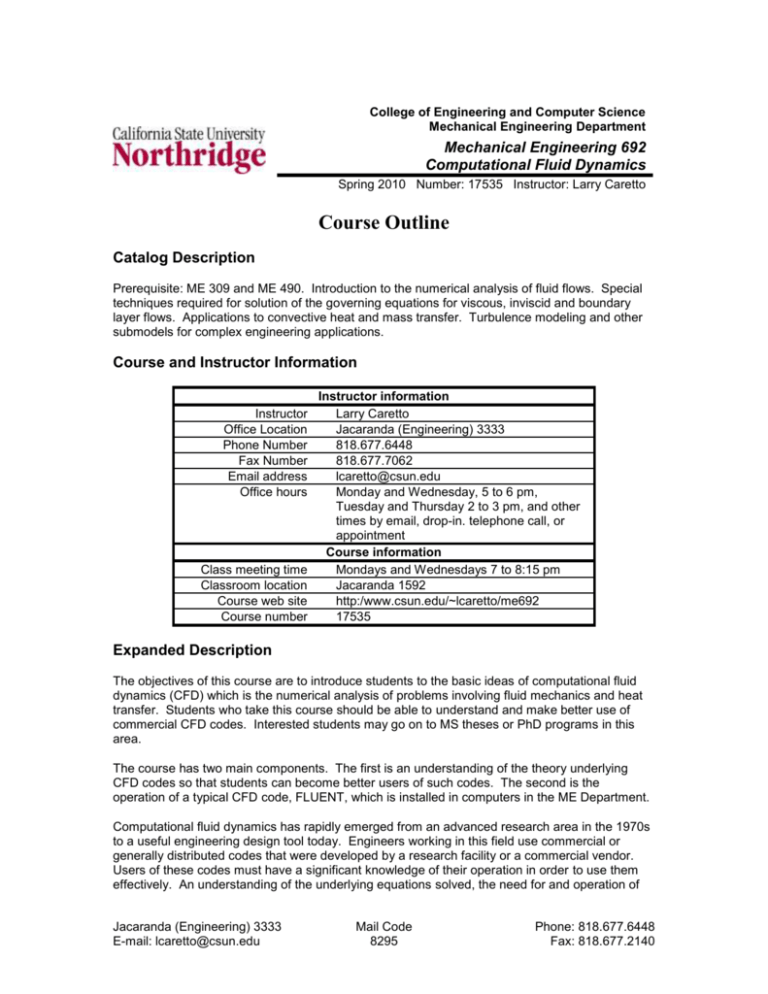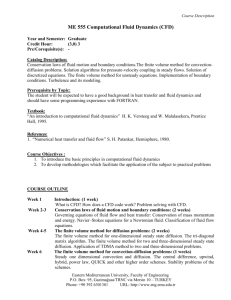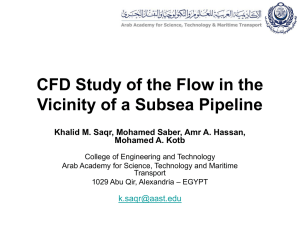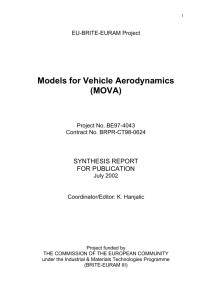
College of Engineering and Computer Science
Mechanical Engineering Department
Mechanical Engineering 692
Computational Fluid Dynamics
Spring 2010 Number: 17535 Instructor: Larry Caretto
Course Outline
Catalog Description
Prerequisite: ME 309 and ME 490. Introduction to the numerical analysis of fluid flows. Special
techniques required for solution of the governing equations for viscous, inviscid and boundary
layer flows. Applications to convective heat and mass transfer. Turbulence modeling and other
submodels for complex engineering applications.
Course and Instructor Information
Instructor
Office Location
Phone Number
Fax Number
Email address
Office hours
Class meeting time
Classroom location
Course web site
Course number
Instructor information
Larry Caretto
Jacaranda (Engineering) 3333
818.677.6448
818.677.7062
lcaretto@csun.edu
Monday and Wednesday, 5 to 6 pm,
Tuesday and Thursday 2 to 3 pm, and other
times by email, drop-in. telephone call, or
appointment
Course information
Mondays and Wednesdays 7 to 8:15 pm
Jacaranda 1592
http:/www.csun.edu/~lcaretto/me692
17535
Expanded Description
The objectives of this course are to introduce students to the basic ideas of computational fluid
dynamics (CFD) which is the numerical analysis of problems involving fluid mechanics and heat
transfer. Students who take this course should be able to understand and make better use of
commercial CFD codes. Interested students may go on to MS theses or PhD programs in this
area.
The course has two main components. The first is an understanding of the theory underlying
CFD codes so that students can become better users of such codes. The second is the
operation of a typical CFD code, FLUENT, which is installed in computers in the ME Department.
Computational fluid dynamics has rapidly emerged from an advanced research area in the 1970s
to a useful engineering design tool today. Engineers working in this field use commercial or
generally distributed codes that were developed by a research facility or a commercial vendor.
Users of these codes must have a significant knowledge of their operation in order to use them
effectively. An understanding of the underlying equations solved, the need for and operation of
Jacaranda (Engineering) 3333
E-mail: lcaretto@csun.edu
Mail Code
8295
Phone: 818.677.6448
Fax: 818.677.2140
Course Outline
ME 692, L. S. Caretto, Spring 2010
Page 2
turbulence models, and the numerical procedures used in CFD is an important factor in this
effective use. Students who successfully complete this course should have that basic
understanding that will allow them to use CFD codes effectively.
Students taking this course are assumed to have some background in basic numerical analysis
and in the differential equations of fluid dynamics. These topics will be reviewed briefly at the
start of the course. By the end of the course, students should have a better appreciation of the
physical and numerical bases for common codes used in computational fluid dynamics. They
should also be able to read the literature in the subject.
Text
H. K. Versteeg and W. Malalasekera, An Introduction to Computational Fluid Dynamics The Finite
Volume Method (second edition), Pearson Prentice Hall, 2007, ISBN: 978-0-13-127498-3.
Course Conduct
Active Learning – Students are expected to read the text and notes before class and be prepared
to discuss the material in the text or notes during class. The use of in-class discussion should
enhance student learning as compared to only having lecturing by the instructor.
Course Objectives – as a result of taking this course, students should:
1. Understand how the basic differential equations of fluid dynamics and convective heat and
mass transfer are derived, and understand the similar form of these equations.
2. Be able to apply the knowledge gained in the course in the operation of commercial CFD
codes.
3. Understand the overall process by which numerical solutions of differential equations are
obtained.
4. Understand the three main processes (finite differences, finite volumes, and finite elements)
by which differential equations are transformed into algebraic equations.
5. Be able to convert partial differential equations into finite difference relations and determine
the order of the truncation error.
6. Be able to use concepts of stability to determine appropriate relaxation factors and
dimensionless parameters used as inputs to commercial codes.
7. Understand algorithms of computational fluid dynamics and be able to determine appropriate
ones to obtain solutions from commercial codes.
8. Be familiar with turbulence models and be able to choose an appropriate model for a specific
problem.
Computer Use – The department has twenty-five seat licenses for the use of a commercial CFD
code known as Fluent. This software is available in our classroom, the ME computing facility
located in Jacaranda (Engineering) 1116/1118, and the common computing lab for the College of
Engineering and Computer Science located in JD 1622. Students who do not currently have
access to the ME computing lab should contact the ME Department Office in JD 4513 to get a
lock password. We will be using this code at some times during the course to illustrate the use of
commercial codes. Students will generally use this code for their project (see below), and you will
be asked to run some of the tutorial programs to learn the use of the code. As a commercial
code, Fluent requires the input of geometry and computational grid from some other CAD
package. You can also use the CAD package, Gambit, which is developed by Fluent. The
development of the geometry (and the associated mesh) is perhaps the most difficult and timeconsuming step in using the program. Fluent is generally regarded as the best selling CFD code,
but it is only one of several codes that are commercially available.
Course Outline
ME 692, L. S. Caretto, Spring 2010
Page 3
Grading – Your grade in this course will be based on weekly homework assignments, one
midterm, the final exam and a project report. The project report is discussed in detail below. The
various course requirements will be weighted as follows in computing the final grade:
Homework
10%
Midterm
25%
Project report
25%
Final
40%
The translation of a final numerical score into a letter grade rests solely on the judgment of the
instructor. The following criteria will be used for letter grades. As indicated below, plus-minus
grading will be used in this course.
A:
Student knows almost all of the course material and is able to apply it to new problems
similar to those covered in the course.
A-: Student satisfies one, but not both, of the conditions for an A grade.
B+: Student understands the fundamental aspects of the course and is able to apply this
knowledge to routine uses of computational fluid dynamics.
B-: Student has learned some course material but is not able to apply all the fundamental
points of the course.
C:
Student has failed to demonstrate knowledge of the course material beyond a minimal
level.
F:
Student has violated campus guidelines for submitting work that was not done by the
student.
Plagiarism vs. Collaboration – Students usually work together on assignments. This collaboration
is helpful and encouraged. By working together each of you can improve your learning of the
subject. However, there is a difference between working together to learn the material and
copying another student’s work and passing it off as your own. The latter is a violation of
academic standards and is improper behavior for students preparing for a professional career in
engineering or sciences. Consequently, each student must submit his or her own work to pass
the course.
Identical solutions on quizzes or exams, indicating copying, will result in an F grade in the course
for both students involved. Students who are found cheating by submission of identical
assignments or any other observations will be referred to the Office of the Dean of Students for
disciplinary action.
Project Report – Each student will select a project from the following list:
1.
Running a commercial code available at the student’s work site.
2.
Running a commercial code at CSUN, typically Fluent.
3.
Writing a code to solve a simple CFD problem.
4.
Some other project proposed by the student and approved by the instructor.
Students should prepare a one-page project proposal to be submitted on March 8. Students give
a brief presentation of their projects to the class on May 3 and May 5. A final written report on the
project must be submitted by 11:59 pm on Wednesday, May 12 (two days after the final exam).
Make-up Examinations – Students must complete the project and the final examination to pass
the course. There will be no make-up examinations for the midterm. Students who do not take
the midterm will receive a grade for that examination based on their performance on the final.
Course Outline
ME 692, L. S. Caretto, Spring 2010
Page 4
Late assignments – Late assignments will be assessed a penalty of 10% of the maximum
possible grade for each week for fraction of a week that they are late. If this penalty results in a
negative score for the assignment, a grade of zero will be assigned.
Changes –Students are responsible for all changes to this outline announced in class.
Class schedule
The reading assignments in the text by Versteeg and Malalasekera are shown below as page
numbers following the authors’ initials, V&M. Reading assignments in the instructor’s notes are
indicated by Notes, followed by the index number of the notes.
Date
Lecture Topic
Reading
January 18
Holiday
January 20 Course overview; begin discussion of basic equations in CFD.
V&M 1-13
January 25 Complete derivation of basic differential equations for CFD. Note
V&M 14-26
general form of all conservation equations.
Notes 1
January 27 Introduction to Fluent code. Use of tutorials to determine various
Fluent
inputs. Fluent solution for a mixing elbow with a predetermined mesh. introduction
Setting properties, models, initial conditions, and solution parameters.
tutorial
February 1 Introduction to turbulence. Physics of laminar and turbulent flows.
V&M 40-65
Importance of turbulence in CFD. Need for turbulence models.
Notes 7
Fluctuating quantities in turbulent flow.
February 3 Handling turbulent boundary conditions in codes. Wall functions.
V&M 65-97
Resolving the laminar sublayer. Correct selection of models and grids.
February 8 Use of turbulence models in Fluent. Choosing turbulence models and
setting parameters and wall functions.
February 10 Introduction to the finite-volume method to steady diffusion problems.
V&M 115 Grid and control volume notation. Errors in finite-difference
133 & 445 –
representations.
447
February 15 Numerical analysis and accuracy of problem solving in steady diffusion. Notes 2.3 –
2.11
February 17 Individual practice in Fluent. Students to choose problems depending
on interest and confidence from first two exercises.
February 22 Application of the finite-volume method to steady convection problems. V&M 134Limitations of central difference method.
144
February 24 Assessment of differencing schemes in steady convection problems.
V&M 145Upwind method, hybrid method and quick differencing scheme..
164
March 1
Total-variation-diminishing (TVD) differencing methods. Accuracy
V&M 165improvements with no wiggles.
178
Differencing schemes in Fluent. Effect of user choice of differencing
March 3
schemes on accuracy of results.
March 8
Solving the momentum and continuity equations to get the flow velocities V&M 179and the pressure. Use of the staggered grid. The SIMPLE algorithm.
190
Project proposals due.
March 10 Modifications of the SIMPLE algorithm: SIMPLEC, SIMPLER and PISO. V&M 191Increase in work per step to reduce overall computation time.
211
March 15 Pressure-velocity coupling schemes in Fluent. Effect of user choice
of such schemes on accuracy of results.
March 17 Numerical solution of equations and criteria for convergence of
V&M 212iterations. (See notes 2.26-2.27 and 3.26 – 3.32)
242
March 22 Fluent/Gambit Exercise. Development of grids for known geometry.
March 24 Review for midterm
Course Outline
Date
March 29
March 31
April 5
April 7
April 12
April 14
April 19
April 21
April 26
April 28
May 3
May 5
May 10
ME 692, L. S. Caretto, Spring 2010
Lecture Topic
Midterm
Holiday
Spring Break
Spring Break
Unsteady flows. The distinction (and similarities)between solving
transient flows and iterating steady flow solutions.
Correct implementation of boundary conditions in finite-volume flow
solutions.
Fluent exercise
Determining accuracy of results in CFD. Validation of CFD results.
Grid generation for complex geometries. Finite difference expressions
for unstructured grids.
Convection terms in unstructured grids. Treatment of pressure-velocity
coupling with collocated variables.
Presentation of student projects.
Project presentations continued. Review for final exam.
Final exam, Monday, 8 to 10 pm
Page 5
Reading
V&M 243266
V&M 267284
V&M 283303
V&M 304319
V&M 304319
Homework
Homework assignments and solutions can be downloaded from .
References
Visit the web site http://www.cfd-online.com/ for a comprehensive list of books, journals,
commercial codes, and other references for CFD.
Several journals are available online from the CSUN library. You can also search for topics in
databases of technical articles. To search the library catalog go to http://library.csun.edu/ and
select periodicals. The site http://library.csun.edu/xerxes/multisearch/engineering is the starting
point to find journal articles in various engineering databases. (This site can also be reached by
following links from the library.csun.edu site to Find Articles & Research Data, Engineering, and
Engineering Multisearch.)








